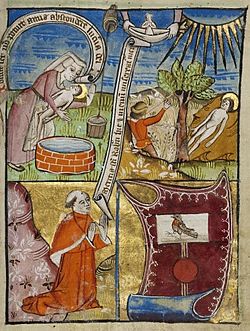Robert of Bury facts for kids
Quick facts for kids Saint Robert of Bury |
|
|---|---|

A 15th-century picture showing the story of St. Robert of Bury. The top left shows a woman near a well, and the top right shows a body by a tree with an archer. The meaning of these parts is not fully known. At the bottom, a monk prays to Robert's soul.
|
|
| Martyr | |
| Died | 1181 Gloucester, England |
| Venerated in | Folk Catholicism |
| Major shrine | Bury St Edmunds |
|
Catholic cult suppressed
|
1536 |
Saint Robert of Bury was an English boy who died in 1181. His body was found in the town of Bury St Edmunds, Suffolk, England. At the time, there was growing unfair dislike towards Jewish people. Because of this, some people falsely blamed local Jews for his death.
Robert became one of a few unofficial English saints from the 1100s. These were all young boys who were found dead in mysterious ways. People claimed they were killed because of false stories about anti-Christian acts by Jews. These false stories are known as blood libel. The first boy to be honored this way was William of Norwich in 1144. His story likely influenced the tales that grew around Robert's death.
Contents
The Story of Robert
How the Story Began
People believed that Robert was taken and killed on Good Friday in 1181. By the 1190s, many people began to honor Robert as a martyr. A monk named Jocelin de Brakelond from Bury St. Edmunds wrote about this time. He also wrote a book about Robert's life and the amazing things people said he did. Sadly, this book has been lost.
The exact details of Robert's death are still unclear. One record says he was "martyred" by Jews around Easter. Later, another record called him "a boy crucified by the Jews." This was part of the false accusations of blood libel.
Poems and Pictures
A poet named John Lydgate wrote a poem called Prayer for St. Robert. This poem suggests Robert's story was much like William of Norwich's. In that story, it was falsely claimed that Jews kidnapped a child with help from a Christian. They supposedly tortured and then crucified him during Easter, making fun of Jesus's death. Lydgate's poem says Robert was "scourged and nailed to a tree."
A picture from a Latin prayer shows Robert lying dead in a ditch next to a tree. An archer is nearby, shooting an arrow upwards. Another picture shows a woman holding the child over a well. The words on this picture say, "the old woman wished, but was not able, to hide the light of God." This woman might be a "nurse" mentioned in Lydgate's poem, possibly a Christian who was falsely accused of helping. Or, she might be a Jewish woman falsely accused of trying to hide the body after the supposed murder.
We do not know much else about the events around Robert's death. We also know nothing about who Robert was, his life, or his family.
Why Robert's Story Was Important
A Local Saint for the Town
Historians believe that the honoring of Robert became popular because of the nearby story of William of Norwich. Bury St Edmunds already had the tomb of St. Edmund the Martyr, who the town is named after. However, William's story was becoming very popular, attracting many visitors. So, having a local boy-martyr like Robert was helpful for the abbey in Bury St Edmunds. It helped them keep their own visitors.
The death of a boy named Harold of Gloucester in 1168 had already shown how William's story could be used. It set a pattern for other unexplained deaths of boys around Easter. This pattern quickly spread to other places.
Impact on Jewish Community
The story of Robert may have played a part in a violent attack on the Jews of Bury St Edmunds. This happened on Palm Sunday in 1190. Fifty-seven Jewish people were killed. After this, the remaining Jewish community was forced to leave the town. This order came from Abbot Samson, a powerful leader of the abbey.
Some historians think that honoring Robert helped to create a negative image of Jewish people. This might have been done to help remove them from the town. However, we do not know enough about the early history of Robert's story to be completely sure. It might have also developed as a way to explain why the Jewish community was expelled later.
See also
Other children whose deaths in medieval times led to the unfair treatment of Jews:
- In England
- Others
- Andreas Oxner
- Werner of Oberwesel
- Simon of Trent
Images for kids


